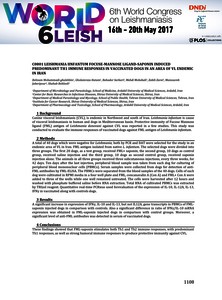محمدی قلعه بین, بهنام ، حاتم, غلامرضا ، سرکاری, بهادر ، محبعلی, مهدی ، زارعی, ذبیح اله ، جابری پور, منصوره ، بهلولی, شهاب (1396) القای پاسخ های ایمنی Th1 غالب توسط فوکوز مانوز لیگاند لیشمانیا اینفانتوم در همراهی با ساپونین در سگ های واکسینه شده در منطقه اندمیک لیشمانیوز احشائی در ایران. در: 6th world congress on Leishmaniasis, May 16-20 , 2017, Toledo-Spain.
متن کامل
![[img]](https://eprints.arums.ac.ir/8968/1.hassmallThumbnailVersion/Worldleish2%20Mohammadi.jpg)
|
متنی
- نسخه چاپ شده
2MB | |
![[img]](https://eprints.arums.ac.ir/8968/6.hassmallThumbnailVersion/WorldLeish-6.jpg)
|
تصویر
90kB |
آدرس اینترنتی رسمی : http://www.worldleish.org
عنوان انگليسی
Leishmania Infantum Focuse-Mannose Ligand-Saponin Induced Predominant Th1 Immune Responses in Vaccinated Dogs in an Area of VL Endemic in Iran
خلاصه انگلیسی
Background: Canine visceral leishmaniasis (CVL), is endemic in Northwest and south of Iran. Leishmania infantum is cause of visceral leishmaniasis in human and dogs in Mediterranean basin. Protective immunity of Fucose Mannose ligand (FML) antigen of Leishmania donovani against CVL was reported in a few studies. This study was conducted to evaluate the immune responses of vaccinated dogs against FML antigen of Leishmania infantum. Methods: A total of 40 dogs which were negative for Leishmania, both by PCR and DAT were selected for the study in an endemic area of VL in Iran. FML antigen isolated from native L. infantum. The selected dogs were divided into three groups. The first 20 dogs, as a test group, received FML+ saponin; the second group, 10 dogs as control group, received saline injection and the third group, 10 dogs as second control group, received saponin injection alone. The animals in all three groups received three subcutaneous injections, every three weeks, for 42 days. Ten days after the last injection, peripheral blood sample was taken from each dog for culturing of peripheral blood mononuclear cells (PBMCs). Serum samples were collected from dogs for detection of anti-FML antibodies by FML-ELISA. The PBMCs were separated from the blood samples of the 40 dogs. Cells of each dog were cultivated in RPMI media in a four well plate and FML, concanavalin A (Con A) and FML+ Con A were added to three of the wells while one well remained untreated. The cells were harvested after 12 hours and washed with phosphate buffered saline before RNA extraction. Total RNA of cultivated PBMCs was extracted by TRIzol reagent. Quantitative real-time PCR was used for evaluation of the expression of IL-10, IL-12A, IL-13, IFNγ in vaccinated along with controls dogs. Results: A significant increase in expression of IFNγ, IL-10 and IL-13, but not IL12A, gene transcripts in PBMCs of FML-saponin injected dogs in comparison with controls. Also a significant difference in ratio of IFNγ/IL-10 mRNA expression was obtained in FML-saponin injected dogs in comparison with control groups. Moreover, a significant level of anti-FML antibodies was detected in serum of vaccinated dogs. Conclusions: These findings showed that FML-saponin stimulates both Th1 and Th2 immune responses, with predominant Th1 responses, as well as strong humoral immune responses to produce protective immunity against CVL.
| نوع سند : | موضوع کنفرانس یا کارگاه (پوستر ) |
|---|---|
| زبان سند : | انگلیسی |
| نویسنده مسئول : | بهنام محمدی قلعه بین |
| نویسنده : | شهاب بهلولی |
| موضوعات : | QX انگل شناسی |
| بخش های دانشگاهی : | دانشكده پزشكي > گروه علوم پایه > بخش انگل شناسی دانشكده پزشكي > گروه علوم پایه > بخش فارماکولوژی |
| کد شناسایی : | 8968 |
| ارائه شده توسط : | دکتر بهنام محمدی قلعه بین |
| ارائه شده در تاریخ : | 17 تیر 1396 05:58 |
| آخرین تغییر : | 24 خرداد 1397 12:07 |
فقط پرسنل کتابخانه صفحه کنترل اسناد





